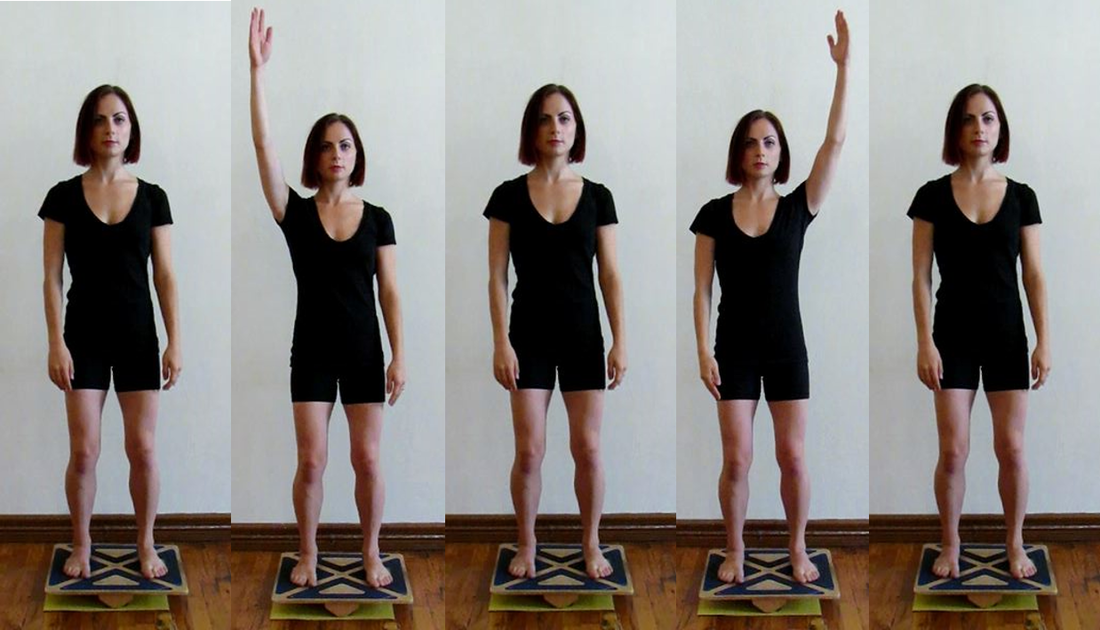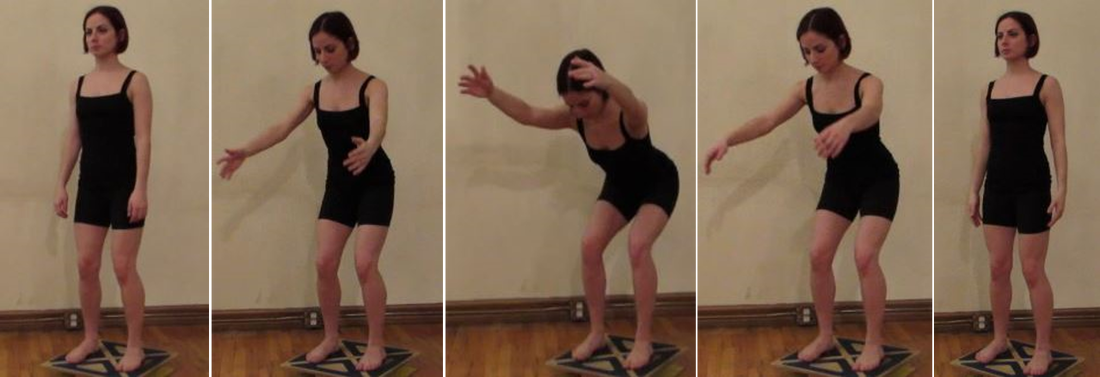1. U/L Arm Raise on Rockerboard

- Stand on a rockerboard with your feet hip width apart and toes facing forward. Engage your core by drawing your belly button to your spine, and find your balance on the board.
- Stand straight and draw your shoulder blades down your back. Raise one arm up over your head while maintaining your core support. Lower the arm back down.
- Repeat with the other arm.
- Keep the arms long the whole way up and down. Be sure not to let the ribs stick out as your arms lift.
- Try to avoid any tension in the neck. Keep your shoulders away from your ears as your arms lift.
- Repeat 10 times each arm.
2. B/L Arm Raise on Rockerboard

- Stand on a rockerboard with your feet hip width apart and toes facing forward. Engage your core by drawing your belly button to your spine, and find your balance on the board.
- Stand straight and draw your shoulder blades down your back. Raise both arms up over your head while maintaining your core support. Lower the arms back down.
- Repeat.
- Keep the arms long the whole way up and down. Be sure not to let the ribs stick out as your arms lift.
- Try to avoid any tension in the neck. Keep your shoulders away from your ears as your arms lift.
- Repeat 10 times.
3. Rockerboard Squats

- Stand on a rockerboard with your feet hip width apart and toes facing forward. Engage your core by drawing your belly button to your spine, and find your balance on the board.
- Crease at your hips and send them back, as if you were going to sit down in a chair. Keep your back straight and your knee caps aligned with your second toes. Lean slightly forward with your torso and let your arms come out in front of you to counterbalance your hips.
- Push down through your heels and activate your glutes to come back up to initial position and repeat.
- Repeat 10 times.
4. Chest Press with Band

- Wrap a theraband around a sturdy object behind you at shoulder level and hold one end in each hand.
- Stand with one leg in front of the other in a split stance, making sure your toes are pointing forward. Bend your knees and draw your belly button to your spine to engage your core and avoid arching in your low back.
- Draw your shoulder blades down your back. Push the band forward by extending the elbows. Make sure your hands are directly out from your shoulders, and avoid any tension in your neck.
- Slowly return to the initial position.
- Repeat 10 times.
5. Standing Hip Abduction

- Tie a theraband in a circle around a secure object (or stand on one end and tie the other end around your opposite ankle). Step inside of the circle so the band is around your ankle.
- Stand on the other leg with your knee slightly bent. Make sure both your hip bones are pointing forward. Lift the leg that is in the theraband to the side and slightly behind you. Keep both hips level and don’t hike the hip of the leg that is lifting.
- Return to the starting position.
- Repeat 10 times.
6. Standing Hip Extension

- Tie a theraband in a circle around a secure object (or stand on one end and tie the other end around your opposite ankle). Step inside of the circle so the band is around your ankle.
- Stand on the other leg with your knee slightly bent. Make sure both your hip bones are pointing forward. Lift the leg that is in the theraband to the back. Keep both hips level and pointing forward. Keep your core engaged so you do not arch your low back as your leg lifts.
- Return to the starting position.
- Repeat 10 times.
The information provided in this blog by James Fowler PT is for general informational and educational purposes, and should not be considered medical advice for any individual problem you may have. This information is not a substitute for the professional judgment of a qualified health care provider who is familiar with the unique facts about your condition and medical history. You should always consult your health care provider prior to starting any new treatment, or terminating or changing any ongoing treatment. Every post on this blog is the opinion of the author and may not reflect the official position of James Fowler PT. Please contact us if we can be helpful in answering any questions or to arrange for a visit or consult.
Images provided by: Physiotec.org & James Fowler PT, PC
